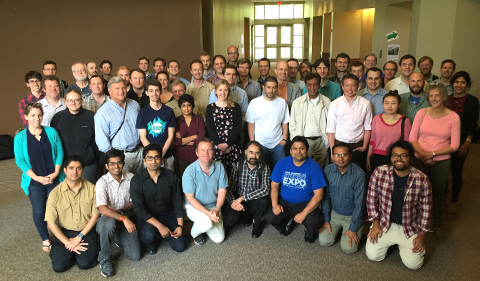
JINA CEE conference attendees
Two special Physics & Astronomy events—the “JINA-CEE Satellite Workshop on Experiments for X-ray Burst Nucleosynthesis’’ on May 22, 2016, and the “JINA-CEE International Symposium on Neutron Stars in the Multi-Messenger Era: Prospects & Challenges’’ during May 23-27, 2016—took place in Walter Hall 245 in Athens, Ohio.
More than 80 scientists from 12 countries and 14 U.S. states took part in the workshop and the symposium. Graduate students, post-doctoral and junior-level researchers featured prominently in these meetings. Madappa Prakash of Ohio University and Catherine Deibel of Louisiana State University served as chairs of the organizing committees for the five-day symposium and one-day workshop, respectively.
Both events were co-sponsored by the Institute of Nuclear and Particle Physics (INPP) at Ohio University and the Joint Institute for Nuclear Astrophysics Center for the Evolution of the Elements, or JINACEE, of which the INPP is an affiliate member. JINACEE is a Physics Frontier Center, funded by the US National Science Foundation. The center encourages research by addressing fundamental questions about the evolution and properties of matter in the cosmos, and the origin of the chemical elements that make up our world.
The purpose of the workshop was to bring theorists and observers together to foster collaborations, share resources, and discuss new experimental initiatives aimed at improving our understanding of X-ray bursts. Associated with neutron stars, X-ray bursts are characterized by occasional and often periodic emission of short, very powerful bursts of X-rays. Following reviews of observations of X-ray bursts and the understanding gained through model studies, future laboratory experiments using current and future accelerator facilities were identified in the workshop to better understand long-standing puzzles.
The symposium aimed to synergize the expertise of physicists and astronomers to assess the current state of knowledge about neutron stars, and to identify areas in which more work is needed to enable interpretation and extraction of information from astronomical observations.
Several graduate students gave excellent talks on frontier topics such as neutron stars with unusually high magnetic fields (called magnetars), mass and radius measurements of neutron stars, and the recent direct observations of gravitational waves predicted by Einstein a century ago.
Progress made with NASA’s Neutron Star Interior Composition Explorer, NICER, India’s Multi-Wavelength Astronomy Satellite, ASTROSAT, and the search for gravitational waves using high precision radio millisecond pulsar timing in the NANOGrav project were reported and discussed.
In addition to talks and in-depth discussions on core-collapse supernova explosions, the birth of neutron stars, and other topics, a recurring theme in the symposium was the radius of a neutron star. A precise knowledge of a neutron star’s radius sheds light on the fundamental interactions that are responsible for creating the densest form of observable matter in the Universe.
Slides of all presentations and photographs of participants in the workshop and the symposium can be found at www.phy.ohiou.edu/~SoNS.



















Comments